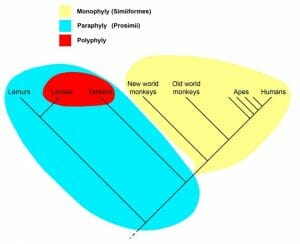Monophyletic Definition
Monophyletic, or monophylogeny, is a term used to describe a group of organisms that are classified in the same taxon and share a most common recent ancestor. A monophyletic group includes all descendants of that most common recent ancestor. The word “mono-phylo-geny” literally translates from Greek into “one-tribe-origin.” A monophyletic taxon is also known as a “clade.”
By classifying organisms based on their biological diversity and evolutionary history, we can study how different organisms, both past and present, are related to one another. In other words this science of systematics helps us understand the evolutionary history of the world.
This system allows us to visualize the relationship of many organisms on a phylogenetic tree or a cladogram, where branching orders show us relationships, and branch lengths show us the amount of evolution.
Some scientists may use a broader definition of monophylogeny that includes paraphyletic groups. A paraphyletic taxon is also defined as a group of organisms sharing a most recent common ancestor; however, a paraphyletic taxon does not include all descendants of that ancestor. But most scientists will distinguish between monophyletic and paraphyletic groups.
Flexibility in Determining Monophyletic Relationships

This figure depicts a cladogram of the order primates and examples of how to classify monophyletic, paraphyletic, and polyphyletic groups. According to this figure, new world monkeys, old world monkeys, apes, and humans belong in the same monophyletic group because we all share a most common recent ancestor. However, organisms can be classified differently, based on which common recent ancestor you choose to begin with.
For example, you can narrow the organisms belonging to a monophyletic group to just old world monkeys, apes, and humans if the most common recent ancestor considered is the old world monkey—or even to just apes and humans if the most common recent ancestor considered is the ape. Conversely, you can expand a monophyletic group to include tarsiers, lorises, and lemurs if the most common recent ancestor in question is the lemur.
Examples of monophyletic groups include: Mammals, birds, angiosperms, and insects. Examples of paraphyletic groups may include: fish, gymnosperms, protists, and invertebrates.
Quiz
1. A group is considered monophyletic if ___________.
A. All members of the group share a common recent ancestor, excluding the ancestor
B. All members of the group share a common recent ancestor, including the ancestor
C. Not all descendants of the common ancestor are included
2. Birds, reptiles, and turtles are all thought to share a common ancestor. Assuming this is true, these groups of animals, including their most common recent ancestor, would be considered what kind of taxonomic group?
A. Monophyletic
B. Paraphyletic
C. Polyphyletic
3. Branching orders in a monophylogenetic group shows us what?
A. Amount of evolution
B. Relationships between organisms
C. Future direction of evolution
References
- Cladogram. (2017, May 14). Retrieved May 21, 2017, from https://en.wikipedia.org/wiki/Cladogram
- Darren Abbey & Brian R. Speer. (n.d.). Graphical explanation of basic phylogenetic terms. Retrieved May 21, 2017, from http://www.ucmp.berkeley.edu/glossary/gloss1/phyly.html
- Monophyly. (2017, May 17). Retrieved May 21, 2017, from https://en.wikipedia.org/wiki/Monophyly
